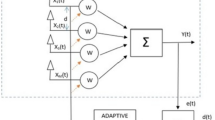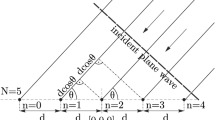Abstract
This paper considers a full-duplex wireless communication system in which detection of the desired signal is hindered not only by the self-interference (SI), but also phase noise, in-phase and quadrature-phase imbalance and power amplifier’s nonlinearity distortion. An iterative algorithm is proposed in which the processes of SI cancellation and detection of the desired signal aid each other in each iteration. In each iteration, the SI cancellation process performs widely linear estimation of the SI channel and compensates for physical impairments to improve the detection performance of the desired signal. The detected desired signal is in turn removed from the received signal to improve SI channel estimation and SI cancellation in the next iteration. Simulation results show that the proposed algorithm significantly outperforms existing algorithms in SI cancellation and detection of the desired signal.



Similar content being viewed by others
References
Zhang, Z., Long, K., Vasilakos, A. V., & Hanzo, L. (2016). Full-duplex wireless communications: Challenges, solutions, and future research directions. Proceedings of the IEEE, 104(7), 1369–1409.
Sabharwal, A., Schniter, P., Guo, D., Bliss, D. W., Rangarajan, S., & Wichman, R. (2014). In-band full-duplex wireless: Challenges and opportunities. IEEE Journal on Selected Areas in Communications, 32(9), 1637–1652.
Duarte, M., & Sabharwal, A. (2010). Full-duplex wireless communications using off-the-shelf radios: Feasibility and first results. The forty fourth Asilomar conference on signals, systems and computers, pp. 1558–1562.
Duarte, M., Dick, C., & Sabharwal, A. (2012). Experiment-driven characterization of full-duplex wireless systems. IEEE Transactions on Wireless Communications, 11(12), 4296–4307.
Li, S., & Murch, R. D. (2014). An investigation into baseband techniques for single-channel full-duplex wireless communication systems. IEEE Transactions on Wireless Communications, 13(9), 4794–4806.
Korpi, D., Anttila, L., Syrjala, V., & Valkama, M. (2014). Widely linear digital self-interference cancellation in direct-conversion full-duplex transceiver. IEEE Journal on Selected Areas in Communications, 32(9), 1674–1687.
Ahmed, E., & Eltawil, A. M. (2015). All-digital self-interference cancellation technique for full-duplex systems. IEEE Transactions on Wireless Communications, 14(7), 3519–3532.
Syrjala, V., Valkama, M., Anttila, L., Riihonen, T., & Korpi, D. (2014). Analysis of oscillator phase-noise effects on self-interference cancellation in full-duplex OFDM radio transceivers. IEEE Transactions on Wireless Communications, 13(6), 2977–2990.
Quan, X., Liu, Y., Shao, S., Huang, C., & Tang, Y. (2017). Impacts of phase noise on digital self-interference cancellation in full-duplex communications. IEEE Transactions on Signal Processing, 65(7), 1881–1893.
Samara, L., Mokhtar, M., Ozdemir, O., Hamila, R., & Khattab, T. (2017). Residual self-interference analysis for full-duplex OFDM transceivers under phase noise and I/Q imbalance. IEEE Communications Letters, 21(2), 314–317.
Austin, A. C. M., Balatsoukas-Stimming, A., & Burg, A. (2016). Digital predistortion of power amplifier non-linearities for full-duplex transceivers. 2016 IEEE 17th international workshop on signal processing advances in wireless communications, pp. 1–5.
Anttila, L., Korpi, D., Syrjala, V., & Valkama, M. (2013). Cancellation of power amplifier induced nonlinear self-interference in full-duplex transceivers. 2013 Asilomar conference on signals, systems and computers, pp. 1193–1198.
Schenk, T. (2008). RF imperfections in high-rate wireless systems: Impact and digital compensation. Dordrecht: Springer.
Rice, M. (2009). Digital communications: A discrete-time approach. Upper Saddle River: Pearson Prentice Hall.
Tse, D., & Viswanath, P. (2005). Fundamentals of wireless communication. Cambridge: Cambridge University Press.
Demir, A., Mehrotra, A., & Roychowdhury, J. (2000). Phase noise in oscillators: A unifying theory and numerical methods for characterization. IEEE Transactions on Circuits and Systems I: Fundamental Theory and Applications, 47(5), 655–674.
Petrovic, D., Rave, W., & Fettweis, G. (2007). Effects of phase noise on OFDM systems with and without PLL: Characterization and compensation. IEEE Transactions on Communications, 55(8), 1607–1616.
Zhao, S., Zhu, X., Wang, H., & Wu, L. (2013). Analysis of joint effect of phase noise, IQ imbalance and amplifier nonlinearity in OFDM system. In International conference on wireless communications and signal processing, pp. 1–6.
Banelli, P., & Cacopardi, S. (2000). Theoretical analysis and performance of OFDM signals in nonlinear AWGN channels. IEEE Transactions on Communications, 48(3), 430–441.
Bussgang, J. J. (1952). Crosscorrelation functions of amplitude distorted Gaussian signals. Cambridge: Research Laboratory of Electronics, Massachusetts Institute of Technology.
Zou, Q. (2008). Signal processing for RF distortion compensation in wireless communication systems. Ph.D. Dissertation, University of California, Los Angeles.
Tubbax, J., Come, B., Van der Perre, L., Donnay, S., Engels, M., De Man, H., et al. (2005). Compensation of IQ imbalance and phase noise in OFDM systems. IEEE Transactions on Wireless Communications, 4(3), 872–877.
Tubbax, J., Come, B., Van der Perre, L., Donnay, S., Engels, M., & Desset, C. (2003). Joint compensation of IQ imbalance and phase noise. In The 57th IEEE semiannual vehicular technology conference (Vol. 3, pp. 1605–1609).
Garcia, M. J. F. G., Paez-Borrallo, J. M., Zazo, S. (2001). DFT-based channel estimation in 2D-pilot-symbol-aided OFDM wireless systems. In 53rd IEEE vehicular technology conference (Vol. 2, pp. 810–814).
Kang, Y., Kim, K., & Park, H. (2007). Efficient DFT-based channel estimation for OFDM systems on multipath channels. IET Communications, 1(2), 197–202.
Hou, X., Zhang, Z., & Kayama, H. (2007). Low-complexity enhanced DFT-based channel estimation for OFDM systems with virtual subcarriers. In IEEE 18th international symposium on personal, indoor and mobile radio communications, pp. 1–5 .
Doukopoulos, X. G., & Legouable, R. (2007). Robust channel estimation via FFT interpolation for multicarrier systems. In IEEE 65th vehicular technology conference, pp. 1861–1865.
Erceg, V., et al. (2004). IEEE P802.11 wireless LANs.
Li, W., Lilleberg, J., & Rikkinen, K. (2014). On rate region analysis of half- and full-duplex OFDM communication links. IEEE Journal on Selected Areas in Communications, 32(9), 1688–1698.
Smaini, L. (2012). RF analog impairments modeling for communication systems simulation: Application to OFDM-based transceivers. London: Wiley.
Author information
Authors and Affiliations
Corresponding author
Additional information
Publisher's Note
Springer Nature remains neutral with regard to jurisdictional claims in published maps and institutional affiliations.
Appendices
Appendices
1.1 Derivation of Eq. (2)
Refering to Fig. 1, after DAC, the signal w(t) is up-converted to a carrier frequency \(f_c\) with quadrature mixers. In the perfect matching case between the I and Q branches, the output of the LO would be
However, the LO is not ideal in practice which results in phase noise and IQ imbalance impairments. Denoting by \(\alpha _T\), \(\theta _T\) and \(\phi _T(t)\) the gain, phase imbalance related to the IQ imbalance impairment and phase offset related to the phase noise impairment, respectively. In practice, \(\alpha _T\) and \(\theta _T\) are static paremeters, while \(\phi _T(t)\) is changing in time. Thus, the output of the LO can be represented as
The expression in (30) can be expanded as in (31)
The term \(I_1\) can be rewritten as
Define
Then
A similar expression can be obtained for \(I_2\) and it is simple to show that
Finally,
The above expression means that the complex baseband equivalent signal of \(z_p(t)\) is \(z(t)={{\mathrm {e}}}^{j\phi _T(t)}\left( \xi _T w(t) + \eta _T w^{*}(t)\right)\).
1.2 Derivation of Eq. (16)
From (1), (2), and (8) one obtains
Thus
Dropping \(T_s\) in (38) results in
in which \(\tilde{q}(n)\) is obtained by downsampling q(n) with factor F, \(n = 0,\ldots ,M-1\).
From (39), \(y_1(k)\) is written as (40)
With the definition of matrices \({\mathbf {Q}}\), \({\mathbf {H}}\) and \({\mathbf {P}}_T\) in Sect. 2, (40) is rewritten compactly as
where \({\mathbf {y}}_1 = \begin{bmatrix} y_1(0)&y_1(1)&\cdots&y_1(N-1) \end{bmatrix}^T\). Similarly, \(y_2(k)\) can be compactly written as \({\mathbf {y}}_2 = {\mathbf {G}}{\mathbf {Q}}{\mathbf {c}}\), where \({\mathbf {G}}\) and \({\mathbf {c}}\) are defined as in Sect. 2.
Rights and permissions
About this article
Cite this article
Le, L.D., Nguyen, H.H. Iterative Self-Interference Mitigation in Full-Duplex Wireless Communications. Wireless Pers Commun 109, 2663–2682 (2019). https://doi.org/10.1007/s11277-019-06702-6
Published:
Issue Date:
DOI: https://doi.org/10.1007/s11277-019-06702-6




